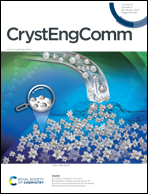Metal–organic architectures driven by a multifunctional 6-aminouracil spacer: structures, noncovalent interactions, and conductivity†
Abstract
Three new coordination polymers, [NaI(H2L)(H2O)3]n (1), {[KI(H2L)(H2O)]8·13H2O}n (2), and {[NiIINaI2(HL)2(H2O)8]·6H2O}n (3), were assembled from 1,3-dimethyl-5-(p-sulfonic-phenylazo)-6-aminouracil (H3L) as a versatile building block. Although azo-coupling reactions generally result in simple azo-compounds, the presence of the sulfonate (–SO3−) group at the ligand frame led to the formation of the NaI-1D (1) or KI-3D (2) homometallic coordination polymer with different ligand coordination modes. Moreover, the heterometallic NiII/NaI-1D (3) coordination polymer was obtained while carrying the reaction of 2 with NiCl2·6H2O. The structures of the obtained products were fully established by single crystal X-ray diffraction and confirmed by standard methods. Compounds 1 and 3 possess 1D metal–organic chains with the 2C1 topology, whereas 2 features a very complex 3D metal–organic architecture with an unprecedented topology. The computational study for molecular electrostatic potential (MEP) surface energies revealed an important finding, namely a decrease of the π-acidity of the uracil ring upon coordination and a consequent increase of the π-basicity of the phenyl-sulfonate ring, resulting in effective anti-parallel π–π stacking interactions in 1 and 2. Finally, a semi-conductive behavior of the obtained compounds was explored using impedance spectroscopy, revealing the very remarkable conductive properties of 1 (2.2 × 10−4 S cm−1), which is a far better conductive material than 2 (7.2 × 10−6 S cm−1) and 3 (4.8 × 10−7 S cm−1). The obtained products represent the first coordination compounds derived from H3L. This study contributes to the design of functional coordination polymers driven by still poorly explored 6-aminouracil building blocks.



 Please wait while we load your content...
Please wait while we load your content...